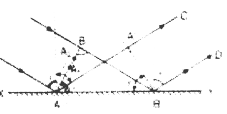Sponsor Area
Interference Of Light
State one condition for obtaining a sustained interference of light.
For sustained interference of light, the two interfering sources must be coherent.
An important component of Michelson’s method to determine speed of light is:
-
A NICOL prism
-
A bi prism
-
A grating
-
An ocatgonal mirror.
D.
An ocatgonal mirror.On the basis of Huygen’s wave theory, show that light is incident on a plane mirror obliquely; angle of reflection is equal to angle of incidence.
Laws of Reflection:
Let XY be a reflecting surface at which a wavefront is being incident obliquely.
Let v be the speed of the wavefront and at the time t =0, the wavefront touches the surface XY at A.
After time t, the point B of wavefront reaches the point B’ of the surface.
According to Huygen’s principle each point 'f' wavefront strikes the reflecting surface, then due to presence of reflecting surface.
It cannot advance further; but the secondary wavelet originating from point A begins to spread in all directions in the first medium with speed v.
As the wavefront AB advances further, its points A1, A2, A3... etc. strike the reflecting surface successively and send spherical secondary wavelets in first medium.
First of all the secondary wavelet starts from point A and traverses distance AA’(=vt) in first medium in time t.
The point B of wavefront, after travelling a distance BB’ reaches point B’ (of the surface), from where the secondary wavelet now starts.
Now taking A as centre we draw a spherical arc of radius AA’ (= vt) and draw tangent A’B’ on this arc from point B.
As the incident wavefront AB advances, the secondary wavelets starting from points between wavefront A’B’ represents the new position of AB, i.e., A’B’ is the reflected wavefront corresponding to incident wavefront AB.
Now in right-angled triangles ABB’ and AA’B’
Angle ABB’ = AA’B’ (both are equal to 90°)
side BB’ = side AA’ (both are equal to vt) and side AB’ is common i.e. both triangles are congruent.
Angle BAB - angle AB’A’
That is, incident wavefront AB and reflected wavefront A’B’ make equal angles with the reflecting surface XY.
As the rays are always normal to the wavefront, therefore the incident and the reflected rays make equal angles with the normal drawn on the surface XY.
i.e., angle of incidence I = angle of reflection r
This is the second law of reflection.
(i) What is a continuous emission spectrum? Name one source of light which produces such a spectrum.
(ii) Explain in brief why dark lines are observed in the solar spectrum.
(i) Continuous emission spectrum: It consists of continuous bright spectral lines without any gap. It is produced by a source in bulk, e.g. tungsten filament, live candle etc.
(ii) The dark lines are observed in the solar spectrum because it is absorption Spectrum. The spectrum obtained when light from a luminous body falls on an absorbing material is called the absorption spectrum. The absorption spectrum contains dark part/lines. It is characteristic of absorbing body.
The spectrum of the sun is line absorption spectrum.
Sponsor Area
Mock Test Series
Mock Test Series





